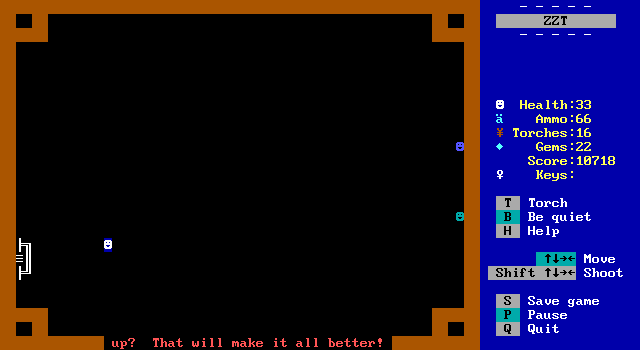
Our Patron selected article for November is Tomas Guinan's Sewers of ZZT. It also happened to be a Patron nominated poll choice as well! Selected by Celine Kalante as being a game that she admits is terrible, but was somehow a favorite in her youth that served as major inspiration for her own creative works.
I think this sort of game as inspiration is something that a lot of ZZTers had. I can gush over the Link's Adventure series which is 90% shooting piles of lions in empty rooms and 10% shooting 200 bullets in a row to stunlock bosses that throw an endless amount of stars, but it's one of my favorite ZZT games and inspired me immensely.
Sewers meanwhile is just one of many ZZT games seems to have not gotten any attention. It did gain at least one fan apparently! Aside from that it has no reviews and just didn't make an impact. It's also a delayed release according to the text file and title screen. It looks to have been finished in 1997 but never actually published until 2001, which is a pretty substantial gap and makes Sewers seem even less noteworthy with how much more dated it would have been when it was actually released.
Sewers of ZZT is basically a Town of ZZT remix, the type of game whose format would be considered retro in 2001, but merely a little dated in 1997 when the game was actually finished.

Celine warned me about this game, letting me know it was not good, not funny, and was homophobic. I definitely went into it expecting the worst, but I could see the charms. Look at this little top hat and cane! It's cute. The title begins going through the cast of characters, running through the player, the stupid security guard, and Radioactive Man (not related to The Simpsons character).
This empty title screen whose title appears and a cast of the game's characters that interact was a major staple of ZZT games after Alexis Janson's release of Mission: Enigma whose introduction clocks in at more than five minutes in length. It became very in vogue to create lavish titles screens that served as the player's introduction to the game's characters and story and many title screens will appear to be completely blank the moment they first load because of this trend.

Guinan describes his game as "kind of like town of zzt only different" which is apparent as soon as the game begins. This town is a bit more modern looking, both in its graphical presentation with some shading, as well as in the actual buildings included. You've got everything a modern town in 1997 would have, a mall, a jail, some US highway roadsigns, and a sewer.
Unlike Town where the player is free to go anywhere from the start, the southern route is blocked off entirely. There's more of a story to Sewers which doesn't lend itself to the nonlinear format used by Town.

Said story is not particularly great. Four yellow keys instead of five purple ones, and then getting some kind of sword to defeat an evil dragon on top of the mountain. The opening also declares itself to be one of the biggest ZZT games out there. It clocks in at 40-something boards which to me is a moderately sized game, but lots of them are fairly limited in what you can do on them. It'd probably take you longer to play Town instead.

The player can also beg for some hints (it takes a few prompts before actually getting them displayed). Most of the hints are relevant, although how they're relevant isn't immediately obvious. "The Lost Forest in Zelda was North, West, South, West", "Skeletons generally don't like getting burnt.", "Friends are there to push around when ever you're in trouble." all make sense to me after having played the entire game, but from the start some of them sound more like jokes than actual advice.

Being a Town derivative it makes sense to head to the mall which is blatantly a remake of Town's armory.

It's definitely been modernized though! Walking into storage causes the security guard to see the intrusion via camera and head over to the player to kill them with stars. The solution is to ring the doorbell first and run across the board before the guard gets back to their computer. I think it's a fun remix of Town's classic doorbell puzzle.
In addition to the storage, there's the usual shop that sells ammo and torches just as you'd find in Town along with an inn that offers 100 health for 10 gems. Contrast this to Town where health is a finite resource only replenished very slowly by collecting gems. Really the game starts off pretty strong here.
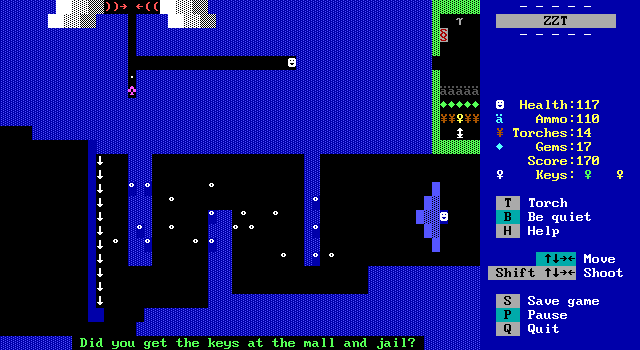
The west is a strange alternative to the three lakes board from Town. While the mall was a nice upgrade, everything here looks messier than the original board, and there's some very strange things going on up top whose purpose won't become clear for some time. A scroll warns about needing keys from the other paths before proceeding which makes me question the point of structuring the game like Town of ZZT if it's so much more linear.

So up north is the path to the jail which involves running across a board before duplicators overwhelm the player with stock enemies. Then there's a short cave maze to go through before finally arriving in the chamber of the skeleton king shown here.


The king will only let the player leave if they fight his warrior without using any weapons. It's a unique boss fight where the warrior follows the player slowly, and attack if the player gets too close. As one of the earlier hints mentioned, skeletons don't like fire, and the way to win this fight is to manipulate the object into being surrounded from three sides by the large flaming torches in the room.
The perspective on the throne here is also really good. The skeleton king standing on it, not as much, though his own design is pretty great.

The exit from the throne room leads to the jail proper where the player is given a single key and their choice of six cells to open. Five of them result in the game becoming unwinnable, either by just having the prisoner attack the player or not doing anything at all. The correct cell has a thankful prisoner who gives the player a key to leave.
And so we run into the first issue with the game here. This isn't really a puzzle, and the different reactions each prisoner has to being freed doesn't matter at all. I was surprised they didn't all just kill the player. One takes gems for no real reason? I mean, the game already can't be beaten.

Before the player can really leave, they have to get past some cops that will begin firing. When they're killed they leave a corpse, which could potentially lead to blocking off the path, but the game does allow the player a chance to move the bodies around if necessary. How thoughtful of Sewers to avoid the possibility of softlocking the game immediately after the board with a 5 in 6 chance of softlocking the game.

With the two keys, the player can proceed west across the bootleg three lakes. The spinning guns here have a high enough firing rate that it can be pretty tough to slip through this last part, at least until I realized that unlike Town's Three Lakes, Guinan never disabled the player's ability to fire, which lets them shoot at the other bullets to destroy them.

Deviating from its Town inspiration, the water continues and there's a palace for the player to enter. I do think Guinan has a solid grasp of creating graphics with line walls, which aren't typically used for creating scenery. The game has a distinct look to it.

Continuing the parallels to Town, this path leads to a difficult puzzle, though one not as well designed as The Rube Board. Half of the challenge here comes from not knowing what the goal really is. The player needs to solve a slider puzzle to get some keys which will let them open doors to get even more keys, doing so until they can make it to the exit.
The idea is sound, and I believe Super ZZT's Monster Zoo has a puzzle based around careful key management as well. After clearing out each area of the puzzle, solving a slider arrangement, destroying some sliders via an object, and defeating all the enemies, they'll receive five blue keys to open the doors and proceed to the next board. The gems are a trick as is the passage, both resulting in the player having to restart.

And then we get something a bit more abstract. This seems like just a strange board, but there's a secret passage if the player is willing to bump against a bunch of walls for no particular reason. I didn't discover the secret on my playthrough, and I'll actually save it for the end because what actually goes on on this board really changed my impression of this game for the worse.

Anyway, the player can go to space now.

There's a fun little scrolling star effect that gets used in a few games. Some objects that are stars all walk in a direction to simulate movement, then turn invisible when they reach the edge of the board and run back to the top. You'll see it in a lot of space themed games.
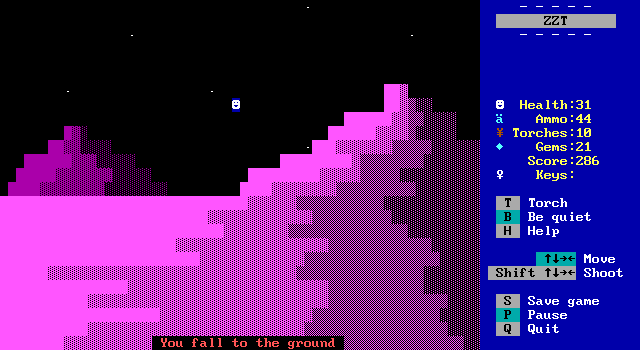
The player arrives on this nice looking purple planet, without the rocket (it's never really explained what happens here) where they die instantly from the landing. Fortunately, radioactive man happens to live on this planet and his radiation bring the player back to life.
Radioactive man explains to the player that they're supposed to destroy the Dragon King on Mt. ZZT by obtaining the sword in the sewers. The player needs to get back to Earth(?) in order to continue their quest. Radioactive man joins the player and offers his help.


Again I want to point out just how good a job this game does with its simple graphics. The cave looks great, and the back view of the couch is pretty fantastic as well.

As is this teleporter to transport the player back to Earth! Graphics are definitely Guinan's strong point, and while the game's the not most compelling to play, there's definitely a lot of pleasant surprises in the visual department.
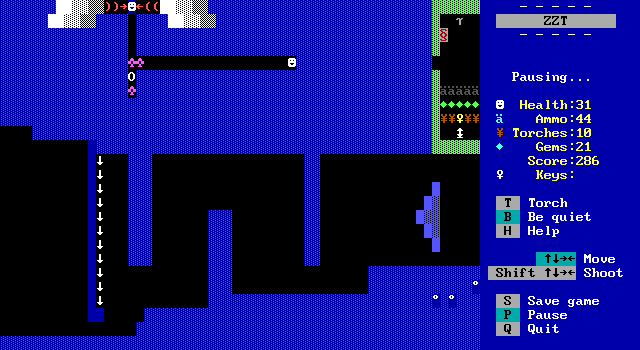
The teleporter brings you back to the ocean board, but from the upper area. Radioactive man appears in front and reminds you to get the key before leaving which is much appreciated not for the reminder, but because it means the player won't immediately be attacked by ruffians since Radioactive man will block them for a bit.

And then you get to this guy. He's here to make sure you picked up every gem available so far and didn't spend any despite there being multiple shops to buy things from! If you did, it's an instant game over. If you don't have all 21 gems you're stuck, and the object also checks if you have more than 21 gems and thus cheated for some. It's really badly designed, going beyond what we've seen in other games where it would turn out I spent too much money to buy something mandatory, and it's completely frivolous.

Jason here takes all your gems and then drinks up enough water to form a path into the corner of the board. Here the player will get their next yellow key to the sewers, some supplies, and an axe.

Again, being a remix of Town at its core, the right path starts out lightly forested, with a rather large tree that prevents the player from continuing until they pick up that axe.
The tree being chopped down is a great animation and it can easily trap or crush a lot of the enemies on the board. For a game with a lot of highs and lows in quality, this is definitely on the higher end of things.

If you took the hints in the beginning, the game will tell you the path through Zelda 1's Lost Woods. Alternatively, if you were me and were tasked with remembering it for your father and older brother as a young child, then up left down left is permanently etched into your brain.

There was a lingering moment of doubt during the maze over whether by backwards the author meant "left down left up" or "down right up right" but my guess of the latter was correct.

Next up is a dark maze which isn't really too much of one. The board has all its edges connected so the screen wraps in every direction. One of the game's hints mentioned that things happen when all the lions are killed in the forest so I sought them all out, and sure enough it opened up the path to the final yellow key. With all of them collected, it was finally time to check out the sewers.


Now freed from the structure of Town, Guinan is able to go in his own direction, which apparently means a sewer full of poop and a single detour route...

...That leads to an insane asylum.

The mental hospital isn't all that uncommon of a setting in ZZT worlds honestly, and I'm kind of surprised its taken us this long to actually get to one. It's about as graceful of a scene here as you'd expect. A few "crazies" for the player to be weirded out by, the author, and what I'm guessing are some of the author's friends that shoot each other repeatedly.


The author has been committed for playing too much ZZT! Fortunately our protagonist sees the cruelty of the system and releases Tomas at once. Now freed, Tomas agrees to find somebody who can shovel the crap in the sewers away so that the player proceed.

The guard meanwhile, is pretty upset about this and begins to attack. You don't actually need to fight them and can walk right out the door, but you're more than welcome to kill them if you like. You don't get anything for it either way.
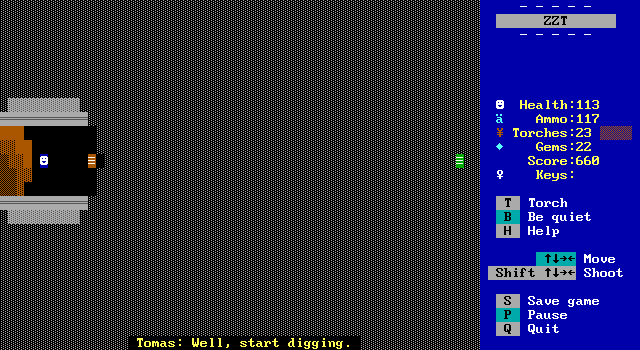
Tomas orders the player to dig, saying that he said he'd find somebody to dig and that somebody is the player.

Me, playing bad ZZT games.

The dark sewers continue, and again the path leads in one direction with another blocked off. This time the culprit is a cracked wall with some sludge oozing out.

The very next board is the Dragon Sword that was alluded to at the start of the game. I think the two characters used to create the sword looks excellent here. There's no real celebration for acquiring it, just a message with a few exclamation points.

Once the player has the sword, the crack in the wall on the previous screen will burst open allowing deeper passage into the sewers.

There's this sort of mini-boss that guards a plunger that a plumber on another screen asks for. The boss can be defeated by shoving sliders up their nose. One of the sliders has already been inserted in this screenshot. To deal with the fact that the sliders need to move horizontally and vertically, the author opts to use code to have them constantly switch between being east-west sliders and north-south sliders. It's a weird choice since boulders exist and function as sliders that work in any direction, but I guess that just doesn't have the same feel when shoving something up a nostril.
Again though, some cool art made out of box drawing characters.
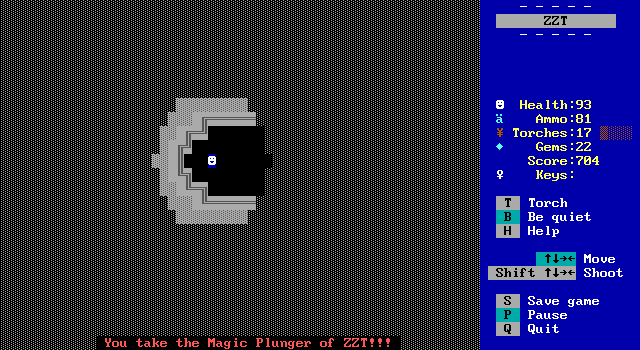
Like the sword, the plunger is there just to be a key to allow access to the next area.

And the next area is the main hub again. After leaving the sewers, they flood outward blocking any attempt of the player to enter them again. The sliders that previously blocked the entrance to Mt. ZZT are also removed letting the player reach their final destination.
It is nice to return the player here again, giving them a chance to spend money at the mall if they're not afraid somebody will kill them for having the wrong number of gems in the future.

After a few boards with various built in monsters and an ever narrowing path, the player arrives at the base of Mt. ZZT where a dragon warns them not to climb the mountain. The background flashes with thunderbolts and lightning to try and make things seem more intimidating, but the player is undaunted and proceeds to climb up with his party of Radioactive man and Tomas.

Cool art alert! The Dragon King looks awesome! Alas, he also needs to be killed, but in order to do that, the player needs to defeat his tiny dragon minion first.
Lots of ZZT games have giant bosses like this, and one thing they all seem to have in common is that they're terrible. Console games in the 80s and 90s would have giant bosses as selling points, and it could certainly be amazing to see something like the dragon in Mega Man 2 for the NES that took up so much space on the screen. These games would get around sprite limits by making the boss mostly be a part of the background layer.
ZZT offers no such thing, so all these giant bosses just stand still and shoot from objects. They're either trivial to beat by standing out of harm's way, or frustratingly difficult if several objects are throwing out stars and overwhelming the player through numbers. By contrast, having the giant dragon king art here and making the player only fight a tiny follower works much better. The player gets a more dynamic fight, but still keeps the cool visuals.

The fight is also pretty unique. There's no given reason for why, but the player is unable to fire bullets on this board. Instead, they need to make their two allies shoot the little dragon. When the player touches an ally, they are shoved a few spaces away, stumble randomly, and shoot away from the player. The concept is cool, but the randomness in how the allies will move when touched makes it lean a little too heavily on luck for actually being to aim at the dragon.

Another issue is that since they will try to move away first, if you're not careful you can get them pinned against a wall or worse, stuck completely in a corner. Having two allies makes it easier to continue the fight if you do slip up however.
The dragon king fades away into oblivion like something out of a Final Fantasy game when defeated. It's a really nice effect and easily the most impressive thing in the entire game. The player is quite pleased with themself, and Tomas suggests a need for some mental help for being so excited about all of this.
Hey now! When Celine nominated this game, she warned me, it's pretty darn homophobic, and playing through it I was pretty confused. There was nothing I saw until this moment at the end of the game. And yeah, it's a weird out of the blue homophobic remark, but Celine made it sound way worse. Surely it couldn't just be this one strange scene with a single line using a slur I forgot even existed? I mean, she said she understood if I didn't want to cover it.
It's tasteless, sure, but it was way less than I was expecting. At least until I was talking with Celine later and realized that I had indeed missed something. It turns out that in that weird room in the castle with the "Aren't you glad you're not up there" text, there's a hidden passage that lets you talk to the objects, and one of them has this conversation...

Yikes. I'm honestly really glad I missed it, since it would've killed what interest I still had in an otherwise pretty unremarkable game. I guess the protagonist just decides to murder a gay man and refer to him as an "it".
So yeah! There's a few creepy moments where the author takes some time away from the game to make sure we're very much aware that he is not a fan of gay people!

After that jarring moment, the player returns back to the hub one last time for the ending. The author admits there is none, but is convinced that something has to happen at least.

So the dragon king's minions show up all at once to get revenge. It's all a trick though, the player is surrounded by some invisible walls and can't actually be hurt by the horde. Instead, Alan (who? If they showed up earlier they didn't have an impact.) shows up and defeats them with a very large belch.

The belch is so powerful that everything is destroyed. Except the signs since they're made out of text and very sturdy. Just like NextGame 33 the author is ready to explain away the signs remaining when the rest of the board is destroyed.
The credits pop up, crediting Tomas and a few of his friends (or so I'm guessing), and the game over is swiflty invoked. That's the end of this bizarre adventure.
Final Thoughts
Sorry for that sudden letdown at the end. It definitely kills the mood. Poor Sewers is one of many countless ZZT worlds that doesn't really excel in any way. It's got some okay art, and the final boss fight is handled in a novel way, but other than that there isn't much to it. It takes Town and tries to mix it up a little, and it does accomplish that. The locations match nicely, armory, castle, jail, forest, etc. but while Sewers offers a new take on these classic locations, it doesn't offer an exciting one.
It's the sort of game that would be completely forgettable if not for Celine's own personal experience with it. It managed to stick with her in a way that even if it's bad, there's still strong feelings towards it. It may not offer much on its own, but in the greater context of the ZZT community it did offer up inspiration, and through this strange creative endeavor, more strange creative endeavors followed.
I'm probably never going to think of this game again. It's bland, dry, and a little distasteful in its weakest moments, but perhaps the author can take solace in knowing that somebody out there not only enjoyed it, but was inspired by it. It has its own tiny little blip in the history of ZZT, and sometimes that's all you need to have a lasting effect.




